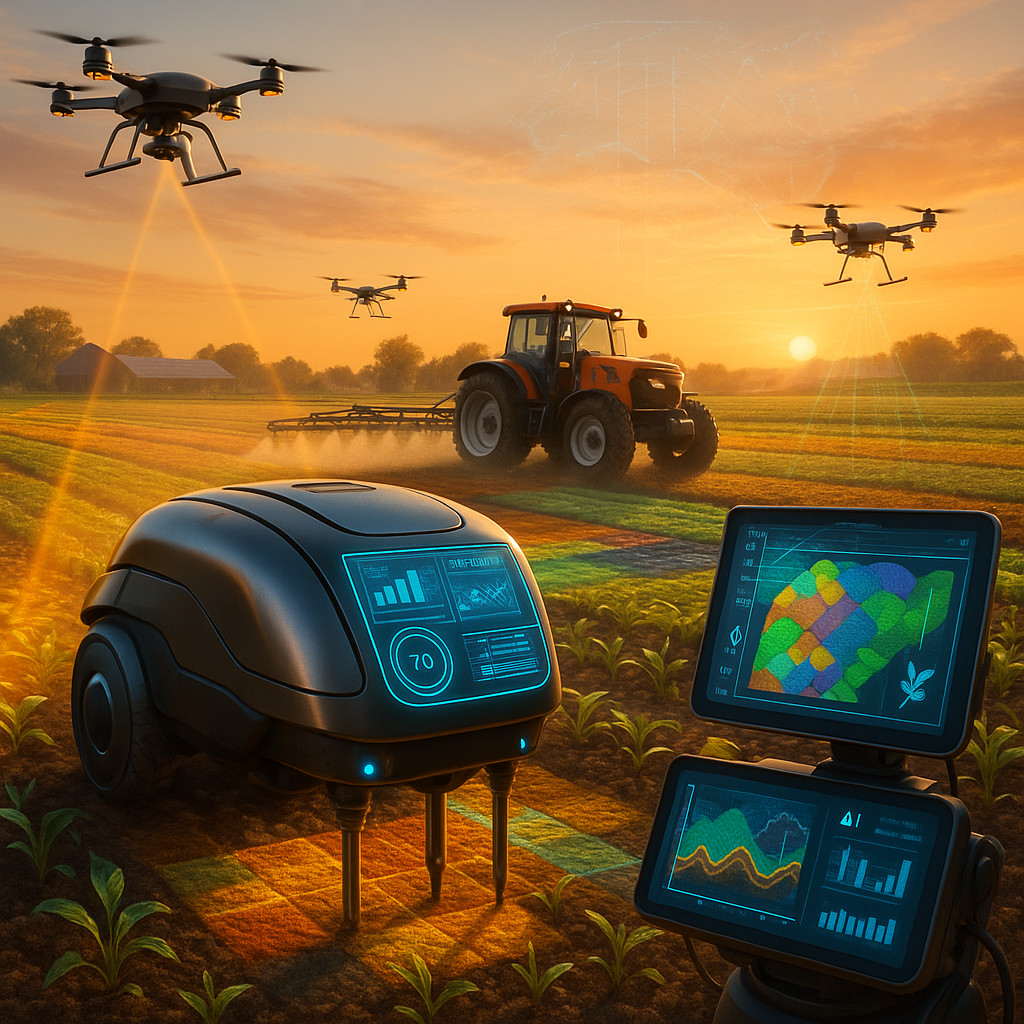Key Takeaways
-
Agriculture AI is swiftly redefining the landscape of soil health and precision farming, empowering farmers to explore and maximize their land’s hidden potential. By merging artificial intelligence with sensor technology and advanced analytics, agricultural professionals are discovering new frontiers in environmental responsibility and productivity, moving beyond the conventional focus on yield.
-
AI-driven soil diagnostics uncover unseen variability. By leveraging real-time sensor data and satellite imagery, AI can detect subtle differences in soil composition, enabling hyper-local soil analysis and fundamentally transforming how fields are managed in agriculture.
-
Precision farming powered by intelligent automation allows machine learning models to interpret sensor outputs and historical data. This enables the automation of critical tasks including irrigation scheduling, nutrient application, and pest management, dramatically increasing accuracy and reducing resource waste.
-
Smart integration with IoT multiplies the impact of these technologies. Connected devices and AI systems create a seamless agricultural ecosystem, supporting autonomous equipment, and providing actionable insights for on-the-ground decision-making.
-
Beyond yield optimization, AI promotes regenerative agriculture at scale. Advanced AI-integrated soil monitoring not only enhances profit margins but also aligns with regenerative practices, fostering soil carbon sequestration and ecosystem recovery, which yields both environmental and economic returns.
-
Data analytics elevate sustainability decisions by providing robust tools that empower farmers to make evidence-based choices about crop rotation, cover cropping, and soil amendment. This leads to improved long-term productivity and sustained soil vitality.
-
Economic value is realized through sustainable practices. AI boosts yields while fortifying the financial and ecological resilience of farms by facilitating the adoption of techniques that restore soil health and reduce dependence on costly chemical inputs.
Together, these innovations position agriculture AI as a force that is fundamentally transforming the meaning of sustainable farming. As we delve deeper, we uncover the synergy at the intersection of intelligence, data, and ecology. This is charting the future trajectory of agriculture far beyond automation.
Introduction
The true potential of any field often lies dormant beneath the surface, waiting for a catalyst like agriculture AI to reveal its secrets. With the ability to decode continuous streams of sensor data and satellite imagery in real time, AI-driven soil diagnostics illuminate intricate patterns of fertility and composition that traditional agriculture often misses. This technological intelligence is not solely about boosting output; it is catalyzing a revolution where every drop of irrigation, application of nutrients, and selection of crop rotation is grounded in scientific precision.
For today’s agricultural professionals, integrating AI with smart technologies signals a pivotal transformation. It’s a shift from reactive to proactive soil health management on a previously unimaginable scale. The result is the widespread adoption of regenerative practices that do more than increase productivity; they restore ecological balance and reinforce the economic foundations of farming enterprises. This article explores how agriculture AI is not just redefining the boundaries of soil health management, but elevating precision farming into a data-powered, adaptive, and sustainable discipline.
The Evolution of Soil Health Management with Agriculture AI
The journey from traditional soil health management to AI-empowered practices illustrates a profound shift. Historically reliant on manual sampling, general recommendations, and inherited wisdom, agriculture is now propelled by sophisticated, real-time analytics that deliver new levels of precision to day-to-day operations.
Stay Sharp. Stay Ahead.
Join our Telegram Channel for exclusive content, real insights,
engage with us and other members and get access to
insider updates, early news and top insights.
 Join the Channel
Join the Channel
From Manual Testing to AI-Driven Analytics
Soil health analysis has advanced through multiple technological epochs:
- First generation (1950s-1990s): Manual soil sampling and lab testing, often with turnaround times stretching from days to weeks.
- Second generation (1990s-2010): Portable soil test kits enable field-level diagnostics, complemented by rudimentary digital mapping.
- Third generation (2010-2020): Remote sensing and early algorithmic interpretation bring new efficiencies.
- Fourth generation (present): AI-enhanced monitoring offers real-time, predictive insights that fundamentally change the soil management paradigm.
This current phase allows AI systems to analyze diverse data streams simultaneously. AI uncovers invisible patterns and illuminates complex relationships between nutrients, microbial communities, climate events, and crop success. The implications are profound across sectors; in vineyards, AI-driven analytics can differentiate subtle terroir effects. In rice paddies, AI models optimize water management for sustainability and yield. Urban farming benefits too, as sensor fusion and analytics transform limited spaces into high-output environments.
Advanced Sensing Technologies and Machine Learning Integration
Modern agriculture AI platforms rely on a varied suite of sensing technologies to capture granular soil health profiles:
- In-situ soil sensors constantly monitor:
- Moisture levels, accurate to ±2 percent
- Nutrient concentrations (nitrogen, phosphorus, potassium)
- Soil pH and salinity, wirelessly transmitting updates every 15-30 minutes
- Microbial presence and enzymatic activity
- Soil organic carbon and sequestration capacity
These sensors feed streams of data into machine learning models that extract meaningful insights. For instance, the John Deere Operations Center platform ingests millions of measurements daily, using neural networks to parse patterns and deliver predictive recommendations. Such adaptive intelligence is equally relevant in forestry (assessing reforestation progress), golf course management (fine-tuning turf health), and horticulture (guiding greenhouse inputs).
High-Resolution Soil Mapping
AI has elevated soil mapping to previously unimaginable resolutions. Where legacy mapping outlined soil characteristics by the acre or hectare, current AI-powered platforms (such as Granular’s Advanced Farming Software) can detect variations at the square meter, sometimes even finer.
A compelling case study from Iowa illustrates AI’s transformative potential. By upgrading to an AI-enabled mapping system, a 5,000-acre farm discovered 27 unique management zones where conventional wisdom spotted just three. The result? A 17 percent reduction in fertilizer use, yields maintained, and input savings that rippled through the operation.
The multidimensional maps now standard in advanced practice integrate:
- Topography
- Water retention and movement
- Dynamic nutrient profiles
- Microbial populations
- Compaction and field traffic patterns
- Longitudinal harvest performance
These layered visualizations equip professionals (whether managing row crops, orchards, or specialty crops) with an unprecedented understanding of their soils. Predictive capabilities, now built into soil analytics apps, allow them to anticipate how changes in management or environment will impact future soil productivity and ecosystem balance. This foundation paves the way for the next generation of precision farming methodologies set to transform agricultural landscapes globally.
AI-Powered Precision Farming Techniques
AI is not merely an aid in precision farming. Frankly, it is the engine that transforms abstract data into practical action, achieving resource optimization and yield gains previously out of reach. Today, managers of vast fields and intensive vertical farms alike are empowered to make granular decisions at previously unmanageable scales.
Variable Rate Application Systems
AI-driven variable rate application (VRA) systems are proving essential in the transition to sustainable agriculture. These intelligent systems use continuous sensor input—from soil probes, drones, and crop imaging—to modulate input rates for seeds, fertilizers, pesticides, and water.
Technical strengths include:
- Seamless integration with wide-area sensor networks, delivering real-time feedback every few seconds
- Processing dozens of data layers for field-by-field or row-by-row recommendations
- On-the-fly input adjustments, accurate within one to two meters
- Machine learning models that grow smarter with every planting and harvest cycle
A groundbreaking University of Nebraska-Lincoln study reports that AI-powered VRA systems led to:
- 23 percent less nitrogen fertilizer applied
- 18 percent reduced pesticide usage
- 12 percent improved water efficiency
- 7 percent yield increases
These figures translate into substantial savings and increased revenue. On a 2,500-acre corn operation, this meant over $110,000 cut from input costs, with an additional $83,000 earned from productivity gains. Such performance extends to diverse settings, from peri-urban greenhouses to international fruit orchards.
Computer Vision for Crop and Soil Monitoring
AI-driven computer vision is redefining agricultural monitoring with speed and accuracy unreachable by human observation.
Leading implementations feature:
- Drone-based imaging, scanning hundreds or thousands of acres per day using multispectral cameras to:
- Detect emerging nutrient deficits days before visual symptoms
- Identify early-stage pest infestations
- Measure waterlogged or stressed zones
- Quantify organic matter distribution
- Tractor- and harvester-mounted camera arrays conducting real-time field scanning for:
- Automated weed identification
- Rapid assessment of plant health and stand counts
- Soil surface analysis for compaction and erosion risk
Blue River Technology’s See & Spray exemplifies this frontier. By separating crops from weeds at high speed, the system enables hyper-targeted spraying, reducing herbicide use by as much as 90 percent without sacrificing control. In horticulture, similar systems optimize thinning and pruning. In viticulture, they detect diseases invisible to the naked eye.
Stay Sharp. Stay Ahead.
Join our Telegram Channel for exclusive content, real insights,
engage with us and other members and get access to
insider updates, early news and top insights.
 Join the Channel
Join the Channel
Autonomous Farm Equipment
Autonomous machinery, guided by AI, is pushing precision and productivity to new levels while freeing human operators for higher-level management and troubleshooting.
Today’s autonomous assets include:
- Self-driving tractors with GPS correction for centimeter-scale accuracy
- Robot seeders and planters individualizing placement and depth by soil parameters
- Smart irrigation rigs adjusting flow rate based on zone-specific moisture
- Robotic weeders decreasing herbicide demand
Evidence from Sabanto’s autonomous planting service shows these systems can operate nearly around the clock, dramatically improve seed placement, and reduce both compaction and labor costs. In addition to broad-acre crops, autonomous solutions are powering precision vegetable cultivation, floriculture, and even agroforestry.
Predictive Analytics for Farm Management
Predictive analytics, powered by AI, are transforming all levels of agricultural planning. These tools can model probable yield outcomes, forecast disease outbreaks and pest pressures, and simulate weather impacts with field-specific granularity.
Widespread applications include:
- Yield forecasting with over 90 percent accuracy for insurance and marketing
- Outbreak prediction of crop diseases 1-2 weeks before symptoms present
- Simulated harvest timing optimization for perishables and grains
- Scenario planning for climate adaptation, irrigation investments, and insurance claims
Farmers Business Network (FBN) leads in this field, using vast datasets to recommend input changes and strategic planning that translates directly to higher net returns per acre. Beyond row cropping, specialty producers, aquaculture specialists, and even vertical farm operators are harnessing predictive analytics for risk management and optimization.
As AI-powered precision farming tools become interconnected via IoT, their aggregate impact is revolutionizing sustainability, efficiency, and profitability. This is paving the way toward a new era of unified, adaptive, and resilient agriculture.
Integrating AI and IoT for Smart Farming
The fusion of artificial intelligence with Internet of Things (IoT) technologies has brought forth a holistic vision for agriculture: smart farming. By linking devices, analytics platforms, and farm machinery into a cohesive network, this system enables intelligent, responsive management at every scale.
Technical Infrastructure for Connected Farming Operations
Effective IoT-based agriculture starts with robust infrastructure:
Key elements include:
- Field sensor networks equipped with wireless, long-range communications (LoRaWAN, Narrowband IoT)
- Weather stations and microclimate monitors for hyper-local forecasting
- On-machine sensors for real-time tracking of equipment and field activities
- Optimized power systems supporting remote operation for years
The data backbone blends edge computing (for local, immediate analytics) with mesh networks and cloud-based data lakes. Systems like OnFarm Connect exemplify this approach, combining diverse communication channels and reliable edge intelligence to deliver near-perfect uptime, even in connectivity-challenged areas. This approach is now being mirrored in viticulture and aquaculture, where reliable, always-on monitoring is critical for environmental compliance and market certification.
Data Flow Architecture for Actionable Insights
Raw data holds little value without the architecture to convert it into clear, actionable insights. Smart farming orchestrates this transformation through a tiered flow:
- Acquisition: High-resolution data from soil sensors, drones, machine logs, and weather scans flows into the system.
- Edge processing: Pre-processing, anomaly detection, and basic analytics occur onsite, enabling instant responses to critical events or errors.
- Cloud analytics: Centralized processing combines multiple sources, runs machine learning diagnostics and forecasts, and synthesizes recommendations.
- Application: User-facing dashboards, automated equipment control, and integration with supply chains and compliance reporting systems ensure data leads to action.
This architecture supports rapid, data-driven decision-making everywhere from major row crop enterprises to remote organic farms and even city-based vertical agriculture projects.
Enabling Regenerative Agriculture at Scale
AI-IoT integration holds the key to scaling regenerative agriculture. This goes beyond simply sustaining soil to actively rebuilding its health and resilience over time.
Benefits reach across industries:
- Hyper-local tracking of soil carbon for participation in climate-smart incentives and carbon markets
- Adaptive management of multi-crop, rotational, and intercropping systems for environmental restoration
- Data-informed precision cover cropping, adjusted in real time by microbial and nutrient sensors
- Integrated livestock monitoring for pasture recovery and erosion prevention
Automated recordkeeping and reporting streamline participation in certification and subsidy programs spanning the globe, from Midwest grain farms to African smallholder cooperatives. These capabilities are also transforming urban farming, where closed-loop feedback enables rapid soil regeneration in intensive environments.
Ultimately, advanced analytics tightly link every management decision with measurable gains in soil health, water retention, biodiversity, and profitability. Markets are already beginning to recognize and reward sustainable practitioners, making intelligent systems not only a tool for stewardship but a springboard for economic opportunity.
Conclusion
The integration of artificial intelligence into soil health management is not simply another technological step forward in agriculture. It is a radical reimagining of how we engage with the land, the ecosystems it supports, and the food we grow. By uniting high-resolution sensing, adaptive machine learning, and tightly woven IoT networks, farmers now possess a level of insight into soil health, nutrient demands, and biological complexity unprecedented in human history.
This revolution’s true power is not just in the ability to boost short-term yields or cut costs. Rather, it lies in facilitating a deeper, more meaningful relationship with the land. Agriculture emerges as a sophisticated system, where each plot is known, each management action is context-aware, and every season becomes a chance to balance productivity with ecological regeneration.
Looking forward, it is those who embrace these “alien minds” (the intelligent systems translating nature’s silent signals) who will shape not only the harvests of tomorrow, but the future of food security and environmental stewardship itself. Whether working in traditional farmlands, innovative urban agriculture, or environmentally sensitive regions, the real question for leaders and stewards alike is not if these technologies will transform agriculture, but how wisely and creatively we will channel their potential. The next era of abundance and sustainability awaits those prepared to listen, learn, and act at the speed of intelligence.





Leave a Reply